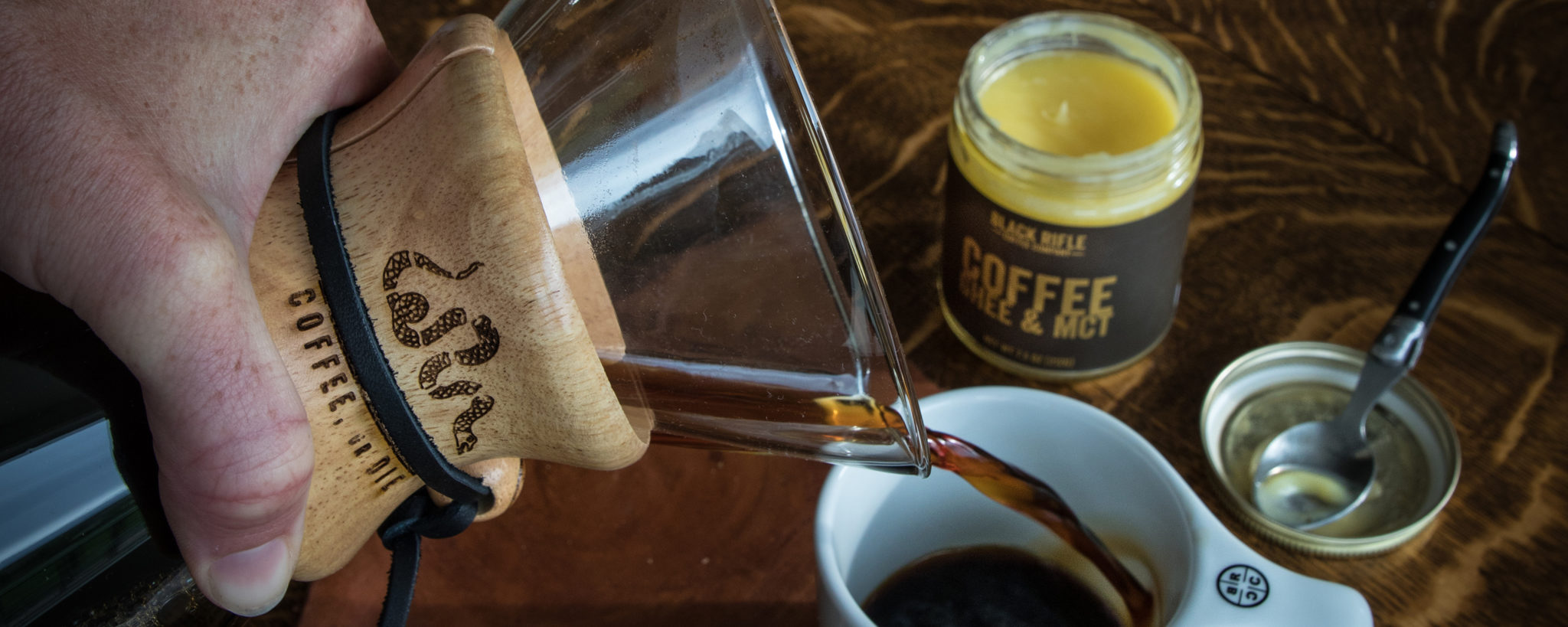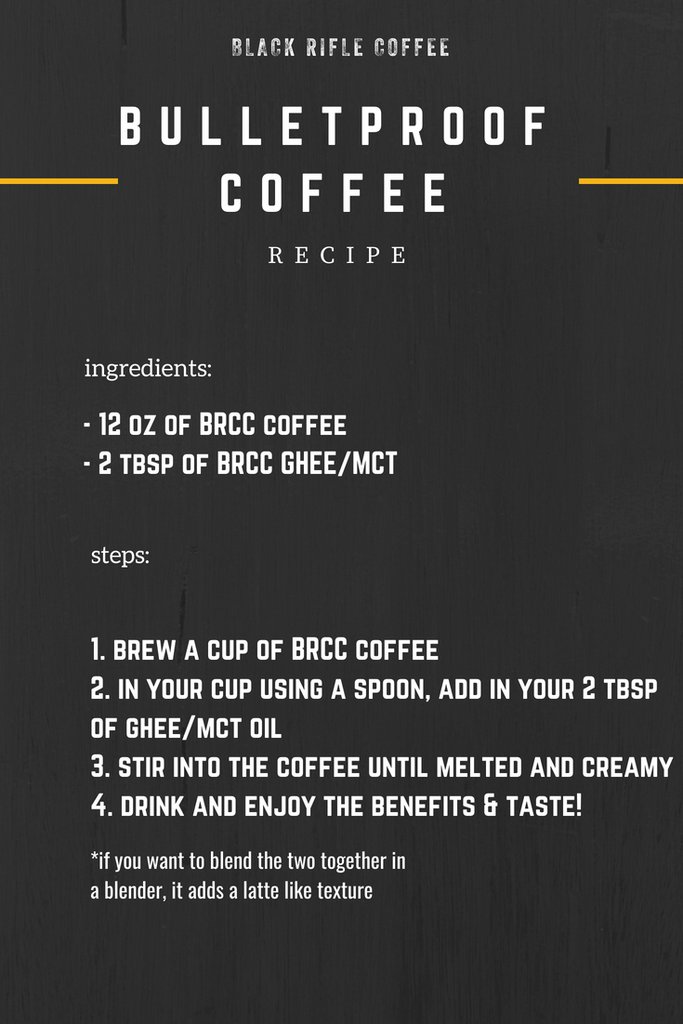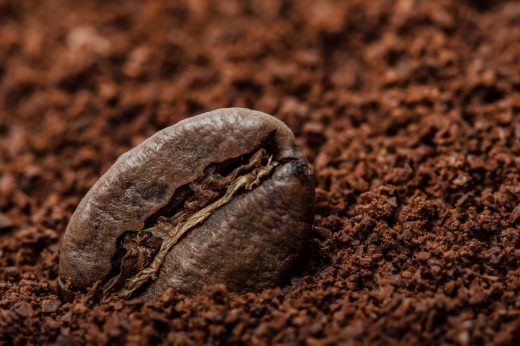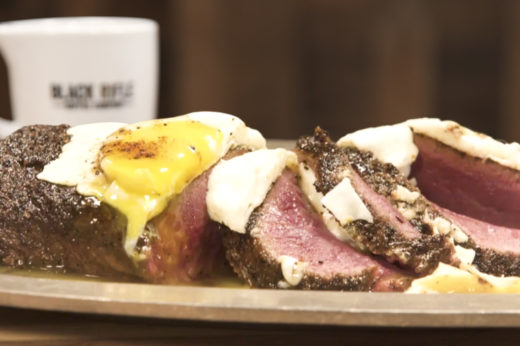Before we address the elephant in the room, let’s take a moment to discuss the difference between fad coffee and legitimate coffee. Fad coffee recipes include most seasonal Starbucks drinks, glitter coffee, coffee in avocado skins, and … well, I’m sure you can think of plenty more. Do some of them taste good? Sure … if you’re into that sort of thing. But do they stand up to the test of time and regular consumption? Hell no!
Black Rifle Coffee Company’s powerful bulletproof coffee sometimes gets roped into this category, but the concoction is actually very legit — and ready to stand the test of time.
What is bulletproof coffee?
Starting at the beginning of time, the human race had a diet that consisted of healthy fats, protein, and vegetables. Western diets have almost entirely eliminated fat, and research stemming from the 2000s are showing an increase in Alzheimer’s and Parkinson’s disease. Why is this?
Dr. Bruce Fife — a certified nutritionist, naturopathic doctor, and author of more than 20 books — dives into this root issue with how Americans are terrified of fat, adding fat, and the understanding of how fat works for the body. When we break down our “American” diets, we think of the original food pyramid we were shown in elementary school — the same food pyramid that was sponsored by companies who profited off the sale of grains and sugars. These pyramids stated the standard adult should consume eight to nine servings of grains and almost no fats, thus starting the low-fat, nonfat scare across America.
In a study cited in Fife’s article, a group of researchers studied 392 individuals for 18 years. The subjects of these tests were over the age of 70 when the study started, and they had their cholesterol and their cognitive functions examined every few months. The subjects that had the highest scores on their cognitive exams coincidently had the highest blood cholesterol levels as well. In layman’s terms, the subjects who had a diet higher in fat showed slower deterioration in their brains; conversely, those who had low cholesterol levels showed lower scores. Along with several other studies from across the world, similar results were occuring for subjects showing a reversal of early Alzheimer’s and Parkinson’s disease symptoms due to added fat in their diets.
The fat idea is starting to penetrate the coffee, fitness, and health world at the moment. Fad diets like high-carb, low-fat are getting run out of the picture, and Americans are starting to take part in their future by educating themselves on the research behind fat.
Have you heard of the ketogenic diet?
A lot of people are increasingly jumping on this research-based diet. This lifestyle of eating brings us back to the beginning of time when our bodies were built for longevity, survival, and strength. What did we eat? We ate vegetables, meat, and high-fat foods. When we talk fat, we aren’t talking Oreos, Cheetos, and cake. Healthy fats are derived from plant and animal sources and include red meat fat, lard, coconut oil, coconut meat, avocado, olive oil, cream, and eggs.
These are the purest forms of fat that our bodies thrive on. The ketogenic diet is a way of eating that mines carbohydrates from fat sources like coconut, vegetables, and avocados, essentially eliminating refined grains. You may be thinking, Isn’t this like the paleo diet? No, this diet is a measurement of your caloric intake until you have an understanding of why you eat this way. Your fat intake should be higher than your protein and your carbohydrate levels. Your body starts to burn fat instead of your carb supply, so when you hit that 4 PM low, you add a high-fat snack into your body rather than a carbohydrate source to stay fueled until dinner. Think about it in terms of what you eat and how it makes you feel.
You hit snooze one too many times, roll out of bed, brush your teeth, throw on work clothes, and head out the door. On your way to work you see a doughnut shop, and you’re hungry. A quick trip to the counter, a cup of coffee, a doughnut or two, and back into the car. Thirty seconds later, you have inhaled a doughnut (all carbohydrates and sugar) and sipped down your coffee. It’s 9 AM when you pull into work, assuming you ate your doughnut at 8:55 AM, and by your 10 AM meeting you are starving and feel your body starting to “crash.” This is when you might think, I’m tired, I overslept, and I need another cup of coffee.
Wrong. Go ahead and have that coffee, but it isn’t about being tired or oversleeping — your choice in breakfast was wrong. Your body immediately turns a doughnut into sugar, thus spiking your blood sugar and immediately giving you a “sugar high” while simultaneously not allowing your body to feed on the fuel you provided, thus metabolizes your breakfast instantly. A simple change of adding two tablespoons of grass-fed butter, coconut oil, or ghee will fill your body with brain-stimulating nutrients. Let’s say you try this on a Friday, the end of a long week but as good a time as any for a change.
On Friday morning, you wake up, roll out of bed, start a pot of coffee, and add oil or butter. Drink down this deliciously creamy drink and head to work. After a busy morning of meetings, you are surprised when the clock is showing noon and you aren’t hungry yet.
WHY? Why is this?
Fat fuels your body, allowing it to feed on the energy you are providing. Fat is brain-stimulating and gets you through the day in a more organic, less up-and-down fashion. And bulletproof coffee can be made anywhere, which is why bulletproof coffee isn’t a fad coffee drink. There is science to back up the idea of adding fat to your coffee, and the added fat gives your coffee a creaminess that you never knew it could have!
How do we make this delicious coffee?
Hands down, bulletproof coffee is the easiest “fancy” coffee drink in the world. All you need is brewed coffee (warm works best), two tablespoons of either BRCC Ghee/MCT, coconut oil, or grass-fed butter, a spoon or a blender, and that’s all she wrote.
This article was originally published Aug. 28, 2018, on Coffee or Die.
Read Next: More stories from Paige Billings.












Comments